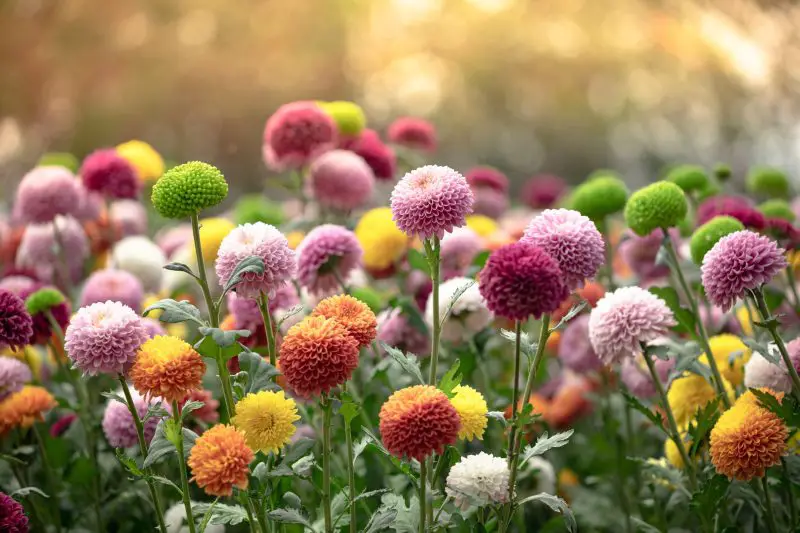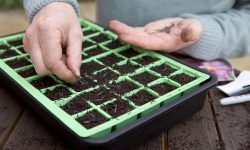Mums, or chrysanthemums, are iconic symbols of fall in the United States, admired for their rich colors and long-lasting blooms. Whether displayed in decorative containers on your front porch or planted directly in garden beds, mums bring vibrancy and warmth to seasonal landscapes.
However, keeping them blooming longer requires more than just placing them in the sun and watering occasionally. Proper care—tailored to their environment, whether in pots or in-ground—can significantly extend their blooming period and maintain plant health well into the season.
Understanding the Growth Habits of Mums

Chrysanthemums come in two main forms: garden mums (hardy mums) and florist mums (less hardy and often used as short-term decor). Knowing the type you’re growing is essential because it affects how you care for them and whether they’ll return next year.
Garden mums are perennials in USDA zones 5 through 9 and can survive cold winters with proper care. They tend to have bushy growth, with dense stems and compact foliage. Florist mums, on the other hand, are bred more for appearance than durability and are typically grown as annuals. Regardless of type, both varieties need attention to soil, light, moisture, and maintenance to produce strong, long-lasting blooms.
Choosing the Right Location for Maximum Impact
Location plays a pivotal role in how well mums perform. These sun-loving plants require full sunlight for at least six hours daily. In gardens, planting mums in an open area where they are not shaded by taller plants or structures ensures even growth and abundant flowering. In pots, mums should be positioned in bright, sunny spots such as patios, porches, or balconies where they receive consistent light throughout the day.
For potted mums, mobility becomes an advantage. You can shift them to follow the sunlight as the seasons change or bring them indoors during extreme cold. Garden mums benefit from being planted in well-drained areas with good airflow to reduce disease pressure and promote strong root development.
Preparing the Soil for Healthy Root Development
A strong start begins with the right soil, as healthy root development directly influences the longevity and vibrancy of mum blooms. For in-ground plantings, the ideal soil is well-draining yet moisture-retentive, with a loamy texture that allows roots to breathe while staying hydrated. Compacted or heavy clay soils can suffocate roots and increase the risk of rot, especially during rainy autumn weeks. To improve structure, work in generous amounts of organic matter such as aged compost, shredded leaves, or well-rotted manure. This not only loosens the soil but also boosts microbial activity, which supports nutrient uptake and disease resistance.
If you’re planting mums in pots, the soil mix becomes even more critical. Choose a high-quality potting mix that contains ingredients like peat moss, perlite, and pine bark to ensure proper drainage and aeration. Avoid using garden soil in containers, as it tends to compact over time and holds too much moisture. Consider adding a slow-release granular fertilizer to the mix before planting to provide a steady supply of nutrients over several weeks.
Before planting, test the soil’s pH—mums prefer slightly acidic conditions between 6.0 and 6.5. Amending overly alkaline soils with elemental sulfur or acidic organic matter like pine needles can help bring the pH into the optimal range. Proper soil preparation not only establishes a healthy root system but also sets the stage for more resilient plants and longer-lasting blooms throughout the fall season.
Watering Techniques to Promote Extended Blooming
Consistent watering is key to prolonged flowering. Mums do not tolerate extremes—neither overly dry nor soggy conditions support optimal bloom longevity.
In gardens, mums should be watered deeply when the top inch of soil feels dry. This encourages roots to grow downward and access moisture from deeper soil layers. Shallow or infrequent watering promotes weak root systems and increases stress during hot spells.
In containers, mums tend to dry out faster due to limited soil volume and exposure to wind and sun. Check moisture levels daily by inserting a finger an inch into the soil. If it feels dry, water thoroughly until excess drains from the bottom. Early morning is the best time to water, allowing foliage to dry before nightfall and minimizing the risk of fungal issues.
Feeding Mums for Continued Flower Production
Pinching and Pruning to Shape and Extend Blooms
Strategic pruning is one of the most effective methods to prolong blooming. Regular pinching early in the season helps develop bushier, more floriferous plants.
For garden mums, begin pinching back new growth in early summer by removing the top inch or two of each stem. This encourages branching and increases the number of flowering tips. Stop pinching around mid-July to allow time for bud formation before fall.
Potted mums purchased in bloom typically don’t require shaping but can benefit from light deadheading. Remove faded blooms by snipping the flower stem back to the next leaf node. This prevents the plant from going to seed and encourages continuous bloom cycles.
Managing Pests and Diseases Effectively
Mums are relatively resilient but can fall victim to common pests such as aphids, spider mites, and caterpillars. Fungal issues like powdery mildew and botrytis may also appear, especially in humid or overcrowded conditions.
Regularly inspect the undersides of leaves and flower buds for signs of pests. A strong blast of water can dislodge small insects, and insecticidal soap or neem oil provides an effective organic option for infestations.
Good garden hygiene helps prevent diseases. Ensure proper spacing, water at the base of plants, and avoid overhead watering. Remove any infected foliage promptly and clean up plant debris around the base to reduce fungal spores and overwintering pests.
Overwintering Garden Mums for Year-Round Beauty
If you’re growing hardy garden mums and want to enjoy them again next season, proper overwintering is essential. Timing and technique determine whether your mums return as strong perennials or perish over winter.
Once the first hard frost arrives and blooms have faded, cut back the stems to about four inches above ground level. Apply a thick layer of mulch—such as straw, leaves, or wood chips—around the base to insulate the roots during freezing temperatures.
In colder regions or poorly drained soils, consider lifting and storing mums in containers. Place them in an unheated garage or shed where they’ll remain dormant until spring. Water sparingly to prevent desiccation without encouraging active growth.
Rejuvenating Potted Mums Indoors
Rejuvenating potted mums indoors allows you to extend their life beyond the fall season and potentially enjoy reblooming in the following year. The key is transitioning them before the first hard frost, while they’re still healthy. Choose a bright indoor spot with at least five to six hours of indirect sunlight daily. If needed, use grow lights to maintain compact growth and support flowering.
Before moving mums inside, prune faded blooms and leggy stems, and inspect for pests like aphids or spider mites. Treat infestations with neem oil or insecticidal soap. Once indoors, reduce watering to prevent soggy soil—let the top inch dry between waterings. Keep the plant in a cool area away from heat vents or cold drafts, ideally between 60–70°F (15–21°C).
Indoor fertilizing should be minimal. Use a diluted, balanced liquid fertilizer monthly only if the plant stays in active growth. If it enters dormancy, stop feeding and reduce watering until spring. Pinch back any stretched stems to promote bushier regrowth, and monitor light exposure closely, as mums need consistent brightness to even attempt reblooming indoors.
With proper light, cooler temperatures, and reduced watering, indoor mums can stay healthy through winter and return stronger for the next growing season.
Common Mistakes That Shorten Mum Bloom Time
Many gardeners accidentally shorten their mums’ lifespan through common missteps. Planting too late in the season, using poor-quality soil, or failing to deadhead blooms all contribute to early decline. Overwatering is a frequent issue, especially in containers, leading to root rot and flower drop. Lack of sunlight also reduces bloom intensity and weakens overall growth.
Avoiding these mistakes and practicing consistent care is the best way to get the most from your mums, whether in pots or the landscape.
Frequently Asked Questions
When is the best time to plant mums in the garden for longer bloom periods?
The best time to plant garden mums is in the spring or early summer, allowing their root systems to establish well before the fall blooming season. Although mums are widely available in garden centers during the fall, those planted late in the season may not survive winter due to limited root development. Spring-planted mums tend to produce more blooms, grow bushier, and are more likely to return the following year.
How do I keep potted mums from blooming too early?
If you purchase mums in early fall and want to delay blooming for a specific event or aesthetic, keep them in partial shade and reduce watering slightly to slow bud development. Avoid feeding them with high-phosphorus fertilizers during this holding phase. Once you’re ready for full bloom, move the pots into full sun and resume regular watering and fertilizing to encourage open flowers.
How often should mums be deadheaded?
Deadheading should be done every few days during peak blooming to remove faded blooms and redirect the plant’s energy into producing new flowers. Use sterilized scissors or snips to cut back to the next healthy leaf node. For larger displays, deadheading may be done once a week, but more frequent attention leads to cleaner, more compact plants and better continuous blooming.
Can mums bloom again after they stop?
Yes, mums can rebloom under the right conditions, especially if deadheaded consistently and grown in mild fall climates. After the first flush of blooms fades, cut the plant back by about one-third and feed it with a low-nitrogen, high-phosphorus fertilizer. Provide full sunlight, maintain moisture, and remove spent blooms regularly. While not guaranteed, this method often triggers a second, lighter bloom before winter frost sets in.
How do I know if my mums are perennial or annual?
You can often tell by how and when the plant was sold. Mums marketed in full bloom during the fall and labeled as “florist mums” are typically treated as annuals and may not overwinter well. Garden mums, labeled as “hardy mums”, are usually sold earlier in the season and can survive winter in zones 5–9 if properly planted and mulched. You can also check the root base after winter—if it’s firm and green at the crown, the plant has survived and will regrow.
What kind of mulch is best for overwintering mums?
Organic mulches such as shredded leaves, pine straw, bark chips, or compost work best. They provide insulation against fluctuating temperatures and help maintain consistent soil moisture. Apply mulch after the first hard frost and cover the root zone with a layer about 3 to 4 inches thick. In spring, gradually remove the mulch to allow new shoots to emerge freely.
Why do the leaves on my mums turn brown or wilt?
Wilting or browning leaves are usually caused by inconsistent watering, root rot, or fungal infections. In pots, underwatering or overly compacted soil can cause roots to dry out, while overwatering leads to soggy conditions that promote rot. In gardens, poor drainage and humid conditions are frequent culprits. Ensure proper airflow, water at the base, and avoid wetting the foliage to prevent disease spread.
Can I divide mums, and if so, how and when should it be done?
Yes, mums can be divided every two to three years to rejuvenate plants and improve bloom production. The best time to divide is in early spring, once new shoots have emerged but before the plant gets too large. Dig up the entire clump, separate the healthy outer portions with several shoots and roots attached, and discard the woody center. Replant divisions promptly in well-prepared soil, water thoroughly, and keep evenly moist until reestablished.
Do mums need to be fertilized during winter?
No, mums should not be fertilized during the winter. Whether they’re overwintering outdoors in the garden or indoors in containers, mums enter a dormancy phase where growth slows or stops. Feeding during this time can stress the plant and encourage weak, leggy growth. Resume fertilization in early spring as new shoots appear.
How do I get compact, bushy mums instead of tall, leggy ones?
The key to compact mums is pinching back the growth regularly during early summer. Start when the plant reaches about 6 inches tall and pinch off the top 1 to 2 inches of each stem. Continue this process every few weeks until mid-July. This encourages lateral branching, resulting in a dense, rounded shape filled with more buds. Avoid late-season pinching, which can delay blooming.
Can mums be grown indoors year-round?
Mums can survive indoors, but year-round blooming indoors is difficult. They require high light levels and a distinct dormancy period. Indoor lighting and temperature fluctuations may stress the plant. If you choose to keep a mum indoors, place it in the brightest window available, avoid dry air from heating systems, and water only when the topsoil feels dry. For best performance, treat indoor mums as seasonal decor and refresh with new plants each fall.
Conclusion: Keeping Your Mums Blooming Longer with Thoughtful Care
Long-lasting mums don’t happen by chance. It takes careful attention to light, water, nutrition, and pruning to help these seasonal favorites reach their full potential. Whether you’re nurturing them in decorative pots or permanent garden beds, every aspect of care—from planting depth to deadheading—affects bloom duration and plant vitality.
By following the practices outlined above, you’ll be rewarded with vibrant, healthy chrysanthemums that brighten your outdoor spaces far longer than expected. With a little knowledge and consistent care, mums can become one of the most reliable and beautiful features of your fall garden year after year.






